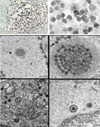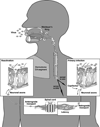Varicella-zoster virus T cell tropism and the pathogenesis of skin infection
- PMID: 20397071
- PMCID: PMC4077053
- DOI: 10.1007/82_2010_29
Varicella-zoster virus T cell tropism and the pathogenesis of skin infection
Abstract
Varicella-zoster virus (VZV) is a medically important human alphaherpesvirus that causes varicella and zoster. VZV initiates primary infection by inoculation of the respiratory mucosa. In the course of primary infection, VZV establishes a life-long persistence in sensory ganglia; VZV reactivation from latency may result in zoster in healthy and immunocompromised patients. The VZV genome has at least 70 known or predicted open reading frames (ORFs), but understanding how these gene products function in virulence is difficult because VZV is a highly human-specific pathogen. We have addressed this obstacle by investigating VZV infection of human tissue xenografts in the severe combined immunodeficiency mouse model. In studies relevant to the pathogenesis of primary VZV infection, we have examined VZV infection of human T cell (thymus/liver) and skin xenografts. This work supports a new paradigm for VZV pathogenesis in which VZV T cell tropism provides a mechanism for delivering the virus to skin. We have also shown that VZV-infected T cells transfer VZV to neurons in sensory ganglia. The construction of infectious VZV recombinants that have deletions or targeted mutations of viral genes or their promoters and the evaluation of VZV mutants in T cell and skin xenografts has revealed determinants of VZV virulence that are important for T cell and skin tropism in vivo.
Figures









Similar articles
-
Investigations of the pathogenesis of Varicella zoster virus infection in the SCIDhu mouse model.Herpes. 2006 Nov;13(3):75-80. Herpes. 2006. PMID: 17147912 Review.
-
Attenuation of the vaccine Oka strain of varicella-zoster virus and role of glycoprotein C in alphaherpesvirus virulence demonstrated in the SCID-hu mouse.J Virol. 1998 Feb;72(2):965-74. doi: 10.1128/JVI.72.2.965-974.1998. J Virol. 1998. PMID: 9444989 Free PMC article.
-
Dissecting the Molecular Mechanisms of the Tropism of Varicella-Zoster Virus for Human T Cells.J Virol. 2016 Jan 20;90(7):3284-7. doi: 10.1128/JVI.03375-14. J Virol. 2016. PMID: 26792747 Free PMC article. Review.
-
A Novel Human Skin Tissue Model To Study Varicella-Zoster Virus and Human Cytomegalovirus.J Virol. 2020 Oct 27;94(22):e01082-20. doi: 10.1128/JVI.01082-20. Print 2020 Oct 27. J Virol. 2020. PMID: 32878893 Free PMC article.
-
Neuronal Subtype and Satellite Cell Tropism Are Determinants of Varicella-Zoster Virus Virulence in Human Dorsal Root Ganglia Xenografts In Vivo.PLoS Pathog. 2015 Jun 19;11(6):e1004989. doi: 10.1371/journal.ppat.1004989. eCollection 2015 Jun. PLoS Pathog. 2015. PMID: 26090802 Free PMC article.
Cited by
-
Varicella-zoster virus infects human embryonic stem cell-derived neurons and neurospheres but not pluripotent embryonic stem cells or early progenitors.J Virol. 2012 Mar;86(6):3211-8. doi: 10.1128/JVI.06810-11. Epub 2012 Jan 11. J Virol. 2012. PMID: 22238301 Free PMC article.
-
Investigation of varicella-zoster virus neurotropism and neurovirulence using SCID mouse-human DRG xenografts.J Neurovirol. 2011 Dec;17(6):570-7. doi: 10.1007/s13365-011-0066-x. Epub 2011 Dec 8. J Neurovirol. 2011. PMID: 22161683 Review.
-
Signal transducer and activator of transcription 3 (STAT3) and survivin induction by varicella-zoster virus promote replication and skin pathogenesis.Proc Natl Acad Sci U S A. 2012 Jan 10;109(2):600-5. doi: 10.1073/pnas.1114232109. Epub 2011 Dec 21. Proc Natl Acad Sci U S A. 2012. PMID: 22190485 Free PMC article.
-
Herpes zoster in psoriasis patients undergoing treatment with biological agents: prevalence, impact, and management challenges.Psoriasis (Auckl). 2016 Oct 18;6:145-151. doi: 10.2147/PTT.S102202. eCollection 2016. Psoriasis (Auckl). 2016. PMID: 29387601 Free PMC article. Review.
-
Congenital and Perinatal Viral Infections: Consequences for the Mother and Fetus.Viruses. 2024 Oct 30;16(11):1698. doi: 10.3390/v16111698. Viruses. 2024. PMID: 39599813 Free PMC article. Review.
References
-
- Arvin AM. Varicella-zoster virus. In: Knipe DM, Howley P, editors. Fields’ virology. 4th edn. Philadelphia: Lippincott-Williams & Wilkins; 2001a. pp. 2731–2768.
-
- Arvin AM. Varicella vaccine: genesis, attenuation and efficacy. Virology. 2001b;284:153–158. - PubMed
-
- Arvin AM, Schaap AC, Ku C-C, Jones JO, Sommer M, Zerboni Z. Investigations of the molecular mechanisms of varicella-zoster virus pathogenesis. In: Sandri-Golden R, editor. The alphaherpesviruses. Horizon Press Inc: UK: 2006.
-
- Baiker A, Bagowski C, Ito H, Sommer M, Zerboni L, Fabell K, Hay J, Ruyechan W, Arvin AM. The immediate early 63 protein of varicella-zoster virus: analysis of functional domains required for replication in vitro and for T cell and skin tropism in the SCID hu model in vivo. J Virol. 2004;78:1181–1194. - PMC - PubMed
-
- Besser J, Sommer MH, Zerboni L, Bagowski C, Ito H, Moffat J, Ku C-C, Arvin AM. Differentiation of varicella-zoster virus ORF47 protein kinase and IE62 protein binding domains and their contributions to replication in human skin xenografts in the SCID-hu mouse. J Virol. 2003;77:5964–5974. - PMC - PubMed
Publication types
MeSH terms
Grants and funding
LinkOut - more resources
Full Text Sources
Medical

